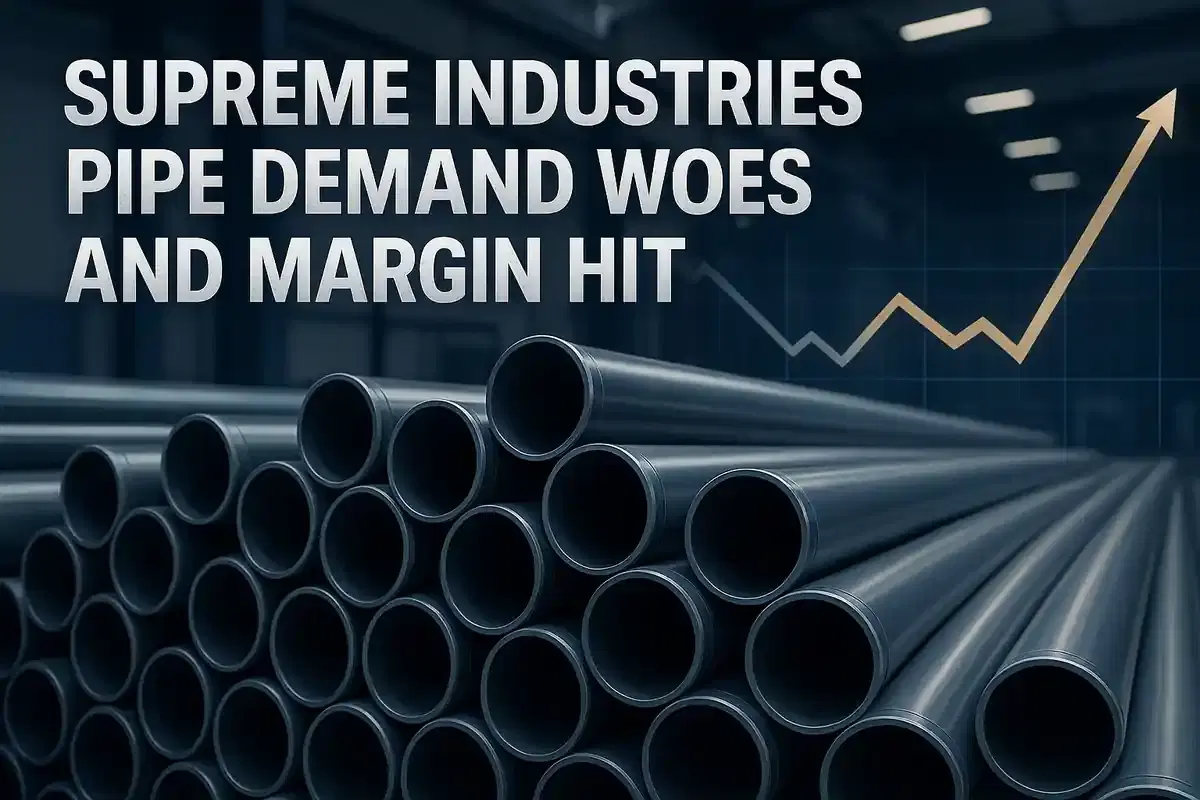Supreme Industries Navigates Demand Woes, Acquisition Costs; Cuts Guidance, Stock Dips
Industrial Goods/Services
|
28th October 2025, 9:17 AM

▶
Stocks Mentioned :
Short Description :
Detailed Coverage :
Supreme Industries Ltd. is looking towards the second half of the financial year 2026 (H2FY26) for relief from the demand and margin pressures it experienced in the first half (H1FY26).
Factors expected to boost earnings include the potential imposition of an anti-dumping duty on PVC resin by November and an anticipated improvement in demand from the agriculture and plumbing sectors.
However, the company's performance in the September quarter (Q2FY26) was mixed. Overall volumes saw a year-on-year increase of about 12%, with the key plastic piping segment growing by 17%. This growth was partly supported by the acquisition of Wavin Industries' plastic pipes business in August.
Despite volume growth, consolidated Ebitda margins declined by 160 basis points year-on-year to 12.4%, falling short of the consensus estimate of 13.6%. This margin pressure was primarily attributed to increased 'other expenses' related to the Wavin acquisition and its integration. Concerns remain that these margin pressures could persist even as volumes rise.
Blended realization prices fell around 6% year-on-year in Q2, mainly due to lower prices in the plastic segment. The company also faced an estimated overall inventory loss of ₹50-60 crore in H1FY26 due to declining prices of materials like PVC, CPVC, and polyethylene.
Management notes that polymer prices have been under pressure but are expected to stabilize, barring significant drops in crude oil prices. Dealer restocking behaviour is highly sensitive to changes in PVC prices.
Following a downward revision in its guidance, the company's stock fell more than 4% on Tuesday. While volume growth guidance for the pipes segment was maintained at 15-17%, the overall volume guidance was lowered to 12-14% (from 14-15%). The upper band of consolidated Ebitda margin guidance was also cut to 14.5-15% (from 14.5-15.5%).
Consequently, various brokerages have downgraded their earnings per share (EPS) estimates for FY26, FY27, and FY28, citing lower margins and higher depreciation following the Wavin acquisition. Supreme Industries has been investing heavily in capital expenditure, with ₹870 crore spent in H1FY26 and a projected full-year outflow of ₹1,300 crore, funded internally, for expansion including new plants expected operational by H1FY27.
Impact: This news has a significant impact on Supreme Industries' stock performance and investor sentiment due to concerns over profitability, integration costs, and revised future outlook. It also highlights broader industry challenges related to input cost volatility and demand fluctuations. The company's stock has underperformed the broader market, down approximately 19% year-to-date in 2025. Impact Rating: 6/10
Heading: Difficult Terms
Respite: Relief or an end to a difficult situation. Patchy: Inconsistent or uneven performance. Buoy: To lift or support something. Muted: Subdued or lacking in energy/activity. Volume: The quantity of goods sold. Segment: A distinct part or section of a business. Consolidated Ebitda margin: A measure of a company's profitability across all its operations before interest, taxes, depreciation, and amortization, as a percentage of revenue. Basis points (bps): A unit of measure equal to one hundredth of a percent (0.01%). 160 bps equals 1.6%. Operating margin: Profitability from core business operations, calculated as operating income divided by revenue. Realization: The price achieved for a product. Inventory loss: Financial loss incurred when the value of unsold goods decreases. PVC (Polyvinyl Chloride): A common plastic material used in pipes, windows, etc. CPVC (Chlorinated Polyvinyl Chloride): A type of PVC that can withstand higher temperatures, used for hot water pipes. Polyethylene: A type of plastic commonly used in packaging and pipes. Polymer: A substance consisting of large molecules, such as PVC or polyethylene. Channel inventory: The amount of goods held by distributors, wholesalers, and retailers. Restocking/Destocking: The process of replenishing or reducing inventory levels in the distribution channel. Guidance: Future financial or operational targets provided by a company's management. Downgrades: When financial analysts lower their previous ratings or earnings estimates for a stock. Earnings per share (EPS): A company's profit divided by the number of outstanding shares. Depreciation: The reduction in the book value of an asset over time. Capital expenditure (Capex): Funds used by a company to acquire or upgrade physical assets. Re-rating: A change in a stock's valuation multiple (e.g., price-to-earnings ratio), either upwards or downwards.